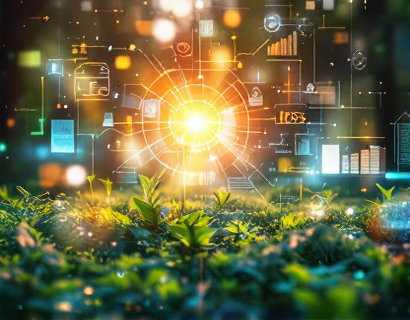Optimizing Horticulture and Farming with Advanced Environmental Analytics for Sustainable Growth
In the quest for sustainable agricultural practices, the integration of advanced environmental analytics stands out as a transformative force. This technology harnesses the power of data to optimize resource management and enhance crop yields, paving the way for a more sustainable future in horticulture and farming. By leveraging sophisticated software tools, farmers and horticulturists can gain deep insights into various environmental factors that impact their operations, leading to more informed decision-making and improved productivity.
Understanding Environmental Analytics in Agriculture
Environmental analytics in agriculture involves the collection, analysis, and interpretation of vast amounts of data related to the farming environment. This data can include soil moisture levels, temperature fluctuations, humidity, sunlight exposure, and more. Advanced analytics software processes this information to provide actionable insights, enabling farmers to tailor their practices to the specific needs of their crops and the conditions of their land.
The core benefit of environmental analytics lies in its ability to transform raw data into meaningful patterns and trends. For instance, by monitoring soil moisture levels in real-time, farmers can optimize irrigation schedules, ensuring that crops receive the exact amount of water they need without waste. This precision not only conserves water but also enhances crop health and yield.
Resource Management Optimization
One of the most significant advantages of advanced environmental analytics is its role in optimizing resource management. Traditional farming methods often rely on fixed schedules and uniform application of resources, which can lead to inefficiencies and environmental degradation. With analytics-driven insights, farmers can adopt a more dynamic and adaptive approach.
For example, precision agriculture techniques enabled by environmental analytics allow for variable rate application of fertilizers and pesticides. This means that resources are applied only where and when they are needed, reducing waste and minimizing the environmental impact. By using sensors and drones to monitor crop health and soil conditions, farmers can make precise adjustments to their resource usage, leading to cost savings and more sustainable practices.
Enhancing Crop Yields Through Data-Driven Insights
Data-driven insights are crucial for boosting crop yields. By analyzing historical and real-time data, farmers can identify the optimal conditions for planting, growing, and harvesting specific crops. This information can help in selecting the best crop varieties, determining the ideal planting dates, and predicting potential yield outcomes.
Environmental analytics can also aid in disease and pest management. By monitoring environmental conditions that favor the growth of pests and diseases, farmers can take proactive measures to prevent infestations. Early detection and targeted interventions can significantly reduce crop losses and improve overall yields.
Promoting Sustainable Practices
The integration of advanced environmental analytics in horticulture and farming promotes sustainable practices by encouraging the efficient use of resources and reducing environmental footprints. Sustainable agriculture is not just about producing food; it's about doing so in a way that preserves the health of the planet for future generations.
For instance, by optimizing water usage through precise irrigation, farmers can conserve this vital resource. Similarly, reducing the overuse of chemical inputs through targeted applications helps prevent soil degradation and water pollution. These practices contribute to a more resilient agricultural system that can withstand environmental challenges and support biodiversity.
Case Studies and Real-World Applications
Several case studies demonstrate the positive impact of environmental analytics on farming and horticulture. In one example, a large-scale vegetable farm implemented a comprehensive analytics system to monitor soil health and moisture levels. The results showed a 20% increase in crop yield and a 30% reduction in water usage. The farm was able to achieve these gains by adjusting irrigation schedules based on real-time soil moisture data.
Another instance involves a horticultural greenhouse that used environmental analytics to optimize light and temperature conditions for different plant species. By fine-tuning these factors, the greenhouse saw a 15% increase in growth rates and a significant reduction in energy consumption. The data-driven approach allowed for precise control over the growing environment, leading to healthier plants and higher yields.
Challenges and Considerations
While the benefits of advanced environmental analytics are clear, there are challenges and considerations that farmers and horticulturists must address. One of the primary challenges is the initial cost of implementing these technologies. High-quality sensors, software, and infrastructure can be expensive, particularly for small-scale operations. However, the long-term savings and increased productivity often justify the investment.
Another consideration is the need for technical expertise to effectively use and interpret the data provided by analytics tools. Farmers may require training and support to fully leverage these technologies. Collaboration with agricultural extension services and technology providers can help bridge this gap, ensuring that users can maximize the benefits of environmental analytics.
Future Trends and Innovations
The field of environmental analytics in agriculture is rapidly evolving, with ongoing innovations poised to further enhance its capabilities. One emerging trend is the integration of artificial intelligence and machine learning algorithms, which can process and analyze data at an even deeper level. These advanced techniques can predict crop yields with higher accuracy, identify optimal planting patterns, and even forecast market trends.
Additionally, the use of Internet of Things (IoT) devices is becoming more prevalent in agriculture. IoT-enabled sensors can provide continuous, real-time data on a wide range of environmental factors, creating a more comprehensive and dynamic picture of the farming environment. This level of connectivity and data flow is essential for achieving true precision in resource management and crop optimization.
Conclusion
Advanced environmental analytics is revolutionizing horticulture and farming by providing data-driven insights that optimize resource management and boost crop yields. These technologies promote sustainable practices, ensuring that agricultural activities are both productive and environmentally responsible. As the world faces increasing challenges related to food security and environmental sustainability, the role of analytics in agriculture becomes ever more critical. By embracing these innovations, farmers and horticulturists can contribute to a healthier planet while securing the future of their operations.










































